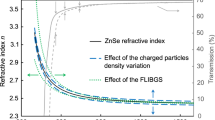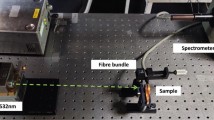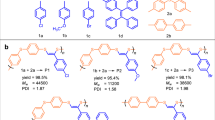Abstract
Electro–optic (EO) modulators are typically made from inorganic materials such as LiNbO3, but replacing them with organic EO materials, that is, ones with optical properties that change in response to an electric field, could be a promising alternative because they offer large bandwidth, ease of processing and relatively low cost. Here we incorporate a doped, crosslinked organic EO polymer into hybrid polymer/sol–gel waveguide modulator devices with exceptional performance. The half-wave voltages of the resulting Mach–Zehnder (MZ) and phase modulators at 1550 nm are 1 V and 2.5 V, respectively. The unique properties of the sol–gel cladding materials used in the hybrid structure result in a 100% device poling efficiency, leading to respective in-device EO coefficients of 138 pm V–1 and 170 pm V–1 in the MZ and phase modulators. These results are the first to show in-device EO coefficients that are five to six times larger than those of the benchmark inorganic material.
This is a preview of subscription content, access via your institution
Access options
Subscribe to this journal
Receive 12 print issues and online access
$209.00 per year
only $17.42 per issue
Buy this article
- Purchase on Springer Link
- Instant access to full article PDF
Prices may be subject to local taxes which are calculated during checkout





Similar content being viewed by others
References
Alferness, R. C. Waveguide electro-optic modulators. IEEE Trans. Microwave Theory Tech. 30, 1121–1137 (1982).
Chen, D. et al. Demonstration of 110 GHz electro-optic polymer modulation. Appl. Phys. Lett. 70, 3335–3337 (1997).
Kim, T.-D. et al. Ultra-large and thermally stable electro-optic activities from Diels-Alder crosslinkable polymers containing binary chromophore systems. Adv. Mater. 18, 3038–3042 (2006).
Enami, Y. et al. Low half-wave voltage and high electro-optic effect in hybrid polymer/sol-gel waveguide modulators. Appl. Phys. Lett. 89, 143506 (2006).
Shi, Y. et al. Electro-optic polymer modulators with 0.8 V half-wave voltage. Appl. Phys. Lett. 77, 1–3 (2000).
Shi, Y. et al. Low (sub-1-volt) halfwave voltage polymeric electro-optic modulators achieved by controlling chromophore shape. Science 288, 119–122 (2000).
Zhang, C., Dalton, L. R., Oh, M.-C., Zhang, H. & Steier, W. H. Low Vπ electro-optic modulators from CLD-1: Chromophore design and synthesis, material processing, and characterization. Chem. Mater. 13, 3043–3050 (2001).
Oh, M.-C. et al. Electro-optic polymer modulators for 1.55 µm wavelength using phenyltetraene bridged chromophore in polycarbonate. Appl. Phys. Lett. 76, 3525–3527 (2000).
Zhang, H. et al. Push-pull electro-optic polymer modulators with low half-wave voltage and low loss at both 1310 and 1550 nm. Appl. Phys. Lett. 78, 3136–3138 (2001).
Park, S., Ju, J. J., Park, S. K., Lee, M.-H. & Do, J. Y. Thermal relaxation trimming for enhancement of extinction ratio in electro-optic polymer Mach–Zehnder modulators. Appl. Phys. Lett. 86, 071102 (2005).
Kuo, Y.-H., Luo, J., Steier, W. H. & Jen, A. K.-Y. Enhanced thermal stability of electro-optic polymer modulators using the Diels-Alder crosslinkable polymer. IEEE Photon. Technol. Lett. 18, 175–177 (2006).
Enami, Y. et al. Poling of soda-lime glass for hybrid glass/polymer electro-optic modulators. Appl. Phys. Lett. 76, 1086–1088 (2000).
Enami, Y., Meredith, G., Peyghambarian, N., Kawazu, M. & Jen, A. K.-Y. Hybrid electro-optic polymer and selectively buried sol-gel waveguides. Appl. Phys. Lett. 82, 490–492 (2003).
Enami, Y., Kawazu, M., Jen, A. K.-Y., Meredith, G. & Peyghambarian, N. Polarization-insensitive transition between sol-gel waveguide and electro-optic polymer and intensity modulation for all-optical networks. J. Lightwave Technol. 21, 2053–2060 (2003).
Enami, Y., Meredith, G., Peyghambarian, N. & Jen, A. K.-Y. Hybrid electro-optic polymer/sol-gel waveguide modulator fabricated by all-wet etching process. Appl. Phys. Lett. 83, 4692–4694 (2003).
Enami, Y., Jen, A. K.-Y., Meredith, M. & Peyghambarian, N. Hybrid electro-optic polymer/sol-gel waveguide modulators fabricated by all-wet etching process, using straight channel and Mach-Zehnder waveguides. Proc. SPIE 5351, 28–35 (2004).
DeRose, C. et al. Pockels coefficient enhancement of poled electro-optic polymers with a hybrid organic-inorganic sol-gel cladding layer. Appl. Phys. Lett. 89, 131102 (2006).
Oh, M.-C., Zhang, C., Lee, H.-J., Steier, W. H. & Fetterman, H. R. Low-loss interconnection between electro-optic and passive polymer waveguides with a vertical taper. IEEE Photon. Tech. Lett. 14, 1121–1123 (2002).
Ahn, S.-W. et al. Integration of electro-optic polymer modulators with low-loss fluorinated polymer waveguides. Opt. Lett. 27, 2109–2111 (2002).
Chang, D. et al. Vertical adiabatic transition between a silica planar waveguide and an electro-optic polymer fabricated with gray-scale lithography. Opt. Lett. 28, 869–871 (2003).
Oh, M.-C. et al. Recent advances in electro-optic polymer modulators incorporating highly nonlinear chromophore. IEEE J. Sel. Top. Quant. Electron. 7, 826–835 (2001).
Paloczi, G. T., Huang, Y., Yariv, A., Luo, J. & Jen, A. K.-Y. Replica-molded electro-optic polymer Mach-Zehnder modulator. Appl. Phys. Lett. 85, 1662–1664 (2004).
Park, S., Ju, J. J., Do, J. D., Park, S. K. & Lee, M.-H. Thermal stability enhancement of electrooptic polymer modulator. IEEE Photon. Tech. Lett. 16, 93–95 (2004).
Kim, S.-K. et al. Side-chain electro-optic polymer modulator with wide thermal stability ranging from –46 °C to 95 °C for fiber-optic gyroscope applications. Appl. Phys. Lett. 87, 061112 (2005).
Kim, S.-K. et al. Electro-optic phase modulator using metal-defined polymer optical waveguide. Appl. Phys. Lett. 87, 011107 (2005).
Taylor, E. W. et al. Radiation resistance of electro-optic polymer-based modulators. Appl. Phys. Lett. 86, 201122 (2005).
Michalak, R. J. et al. High-speed AJL8/APC polymer modulator. IEEE Photon. Tech. Lett. 18, 1207–1209 (2006).
Dalton, L. et al. Acentric lattice electro-optic materials by rational design. Proc. SPIE 5912, 1–12 (2005)
Kang, J.-W., Kim, T.-D., Luo, J., Haller, M. & Jen, A. K.-Y. Very large electro-optic coefficients from in situ generated side-chain nonlinear optical polymers. Appl. Phys. Lett. 87, 071109 (2006).
Luo, J. et al. Recent progress in developing highly efficient and thermally stable nonlinear optical polymers for electro-optics. Proc. SPIE 5351, 36–43 (2004).
Teng, C. C. & Man, H. T. Simple reflection technique for measuring the electro-optic coefficient of poled polymers. Appl. Phys. Lett. 56, 1734–1736 (1990).
Park, D. H., Lee, C. H. & Herman, W. N. Analysis of multiple reflection effects in reflective measurements of electro-optic coefficients of poled polymers in multilayer structures. Opt. Express 14, 8866–8884 (2006).
Acknowledgements
The authors would like to acknowledge support from the National Science Foundation MDITR Science and Technology Center through the University of Washington and the Defense Advanced Research Projects Agency (DARPA) MORPH program. Y.E. thanks the International Communication Foundation, Japan, for travel support. A.K.-Y.J. thanks the Boeing–Johnson Foundation for its support. The authors would also like to thank Lumera Corporation for providing some of the materials in collaboration with the University of Washington, and Warren Herman for his critical reading of the manuscript and comments.
Author information
Authors and Affiliations
Corresponding author
Ethics declarations
Competing interests
The authors declare no competing financial interests.
Rights and permissions
About this article
Cite this article
Enami, Y., Derose, C., Mathine, D. et al. Hybrid polymer/sol–gel waveguide modulators with exceptionally large electro–optic coefficients. Nature Photon 1, 180–185 (2007). https://doi.org/10.1038/nphoton.2007.25
Received:
Accepted:
Published:
Issue Date:
DOI: https://doi.org/10.1038/nphoton.2007.25
This article is cited by
-
Kerr nonlinear effect in the graphene-based wedged hybrid plasmonic waveguide
Optical and Quantum Electronics (2024)
-
Facile fabrication and optical properties of polymer waveguides with smooth surface for board-level optical interconnects
Journal of Materials Science: Materials in Electronics (2022)
-
Compact solid-state optical phased array beam scanners based on polymeric photonic integrated circuits
Scientific Reports (2021)
-
Systematic study of the structure-property relationship of a series of near-infrared absorbing push-pull heptamethine chromophores for electro-optics
Science China Chemistry (2021)
-
High-temperature-resistant silicon-polymer hybrid modulator operating at up to 200 Gbit s−1 for energy-efficient datacentres and harsh-environment applications
Nature Communications (2020)



